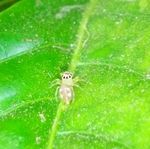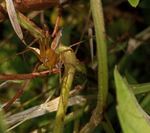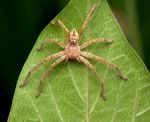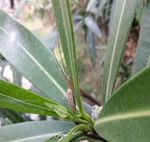Assemblage of spiders diversity - an agent of biological control of agricultural pests
←
→
Page content transcription
If your browser does not render page correctly, please read the page content below
Journal of Applied Entomologist, 2023; 3(1):01-06 ISSN NO: 2583-1917
Assemblage of spiders diversity - an agent of biological control of
agricultural pests
Veeramani A1*, Abinaya D1, Ennavan V1, Bhuvaneshwaran N1, Ravichandran S1 and Pazhanisamy S1
1 Department of Zoology, Government Arts College (Autonomous), Kumbakonam, Tamil Nadu, India
Correspondence Author: Veeramani A
Received 17 Nov 2022; Accepted 20 Dec 2022; Published 3 Jan 2023
Abstract
Arachnids provide an important service by keeping insect populations under control. Spiders are acting as an agent of biological
control of insects; without them many insects would have reached high level of pest proportions. This present investigation was
aimed to attain the diversity of spider fauna of cultivated croplands of Swamimalai Region of Cauvery Delta, Tamil Nadu. The data
on diversity of spiders was investigated by hand picking method. The spotted spider specimens were photographed and left in the
same environment without disturbing it. A total of 31 species of spiders under 13 genera were recorded in buildings, wooded areas
and cultivated regions. Spiders are normally built nests on their living habits for dwelling as well as catching prey which are trapped
in their nests. This is only the baseline study but it needs a long-term inventory which will fulfill the lacunae of spider diversity in
the study area.
Keywords: spiders, arachnids, diversity, biological control, cauvery delta
Introduction researchers to take interest in research on spiders (Veeramani
Spiders are belonging to the class Arachnida and like all other et al., 2021) [24]. According to Ghafoor and Mohamood (2011)
[7]
arachnids, they have two body parts, which are cephalothorax biological control through spiders is one of the best strategies
and abdomen. The abdomen is very soft and are unsegmented to reduce the use of chemical pesticides as well as the
while the cephalothorax is harder having four pairs of legs population of the insect pests. Similarly taxonomic studies of
which is the special characters of spiders differ from others. As spider species from various micro habitats were investigated by
hinted by Oyeniyi Abiola Oyewole (2014) [11] they are lack of various researchers (Vungsilabutr, 1988; Sahu et al., 1996;
wings and antennae. Most of the arachnids are carnivorous in Patal, 2003; Mathirajan and Raghubathy, 2003; Vanitha et al.,
nature and preying on insects and other terrestrial organisms. 2009; Bhatkar, 2011; Phalgum Chetia and Dilip Kumar Kalita,
They provide an important role on keeping agricultural pest 2012 and Mohsin Bukhari et al., 2012) [25, 18, 12, 8, 23, 2, 14, 9]. The
insects under control. It is evident that spiders are acting as present investigation was aimed to carry out survey of spider
biological control agent on controlling insect pests. Spiders fauna in the associated cultivated fields of Swamimalai Region
under the order Araneae are mainly feed on insects. However, of Cauvery Delta, Tamil Nadu. No specific extensive studies
they can consume their food in the form of liquids, since they on spider faunal diversity in this region were done and
are lacking of chewing type of mouth parts. They normally use published. It is the first approach to study the spider fauna, thus
Chelicera, the pointed appendages present in front of the providing base line information for future studies. The
cephalothorax which help to grasp the prey and inject venom. objectives of the study include to estimate the assemblage of
Digestive enzymes are breaking the food down into liquid, spiders diversity in the wooded and cultivated fields, study the
which will be ingested by the spiders. occurrence of spiders in different habitat types and also to
Araneae is one of the largest carnivorous group of animals on suggest suitable conservation strategies for spiders.
the planet. Researchers have recorded over 75,000 species of
arachnids and many more are unrecorded. Diversity, Materials and methods
distribution and feeding habits of insects are suspected of Collection and identification of spiders
playing an important role in the balance of nature (Oyeniyi The diversity and density of spiders was investigated
Abiola Oyewole., 2014) [11]. Foelix (1996) [5] stated that the loss throughout the study period by hand picking method. The
and degradation of natural habitats results in the loss of spotted spider specimens were photographed and left in the
biodiversity worldwide. Continuous degradation and alteration same environment without disturbing it. All specimens were
of tropical forest habitats become serious issue of modification identified using the taxonomic keys for Indian spiders given by
of landscapes. These kinds of developments make critical Tikader (1987) [22], Biswas and Biswas (1992) [3] and Sebastian
consequences to the biodiversity (Tikader, 1987) [22]. It is and Peter (2009) [20]. The diversity of spiders was analyzed by
evident that spiders are friends of farmers as they control extensively used indices viz., The Shannon–Wiener index (H1),
different types of pests on cultivated crops (Veeramani et al., which is responsive to changes in the great quantity of rare
2021) [24]. species in community and the Simpson index (λ), which is
Since now major contributions of research on arachnology was sensitive to changes in the most abundant species in a
made by Pocock and Tikader which made the modern community, and Margalef Richness which were calculated
www.dzarc.com/entomology Page | 1Journal of Applied Entomologist, 2023; 3(1):01-06 ISSN NO: 2583-1917
using biodiversity pro software version 2. Results
Diversity index was calculated by using following formula. A total of 31 species of spiders under 13 genera and 13 families
Diversity index (H`) = -Sum[(pi) * ln(pi)] (Table 1) were recorded during the survey period in buildings,
Evenness (E) = H/Hmax : Hmax = ln(S) wooded areas and cultivated regions of Swamimalai region.
Where, H` = diversity index; Sum = Summation This area is rich in floral diversity. In this observation salticidae
Pi = Number of individuals of species i/total number of samples is the most represented family with 14 species followed by
S = Number of species or species richness Sparassidae with 4 species, Lycosidae and Tetragnathidae had
Hmax =Maximum diversity possible: E = Evenness 2 species each. Other species represent each one family (Fig. 1).
Table 1: Spider species recorded in the study area
Sl. No. Family Species Name Common Name Habit
1 Araneidae Clerck, 1757 Neoscona nautica (L. Koch, 1875) Grey sphere spider Orb Web builders
2 Ctenidae Keyserling, 1877 Ctenus sp. Tropical wolf spider Bark Spider (Ground runners)
Long-spinnered bark
3 Hersiliidae Hersilia clypealis Baehr & Baehr, 1993 Tree trunk spider
spiders and two-tailed spiders
4 Draposa sp. Kronestedt 2010 Wolf spider Bark Spider (Ground runners)
Lycosidae Sundevall, 1833
5 Arctosa littoralis (Hentz, 1844) Beach Wolf Spider Stalkers
6 Evarcha flavocincta (C. L. Koch, 1846) Jumping spiders Stalkers
heavy-bodied jumper (or) semi-
7 Hyllus semicupreus (Simon, 1885) Stalkers
coppered heavy jumper,
8 Hyllus sp. Jumping spiders Stalkers
9 Plexippus paykulli (Audouin,1826) Jumping spiders Stalkers
10 Plexippus petersi (Karsch 1878) Small Zebra Jumper Stalkers
11 Telamonia dimidiate (Simon, 1899) Two striped Jumping spider Stalkers
12 Telamonia c.f. festiva var. Thorell,1887 Jumping spiders Stalkers
Salticidae Blackwall, 1841
13 Brettus cingulatus Thorell, 1895 Jumping spiders Stalkers
14 Telamonia dimidiata (Simon 1899) Two-striped jumper Stalkers
15 Lyssomanes viridis (Walckenaer, 1837) Magnolia green jumper Stalkers
16 Carrhotus viduus (C. L. Koch, 1846) Jumping spiders Stalkers
17 Chalcotropis pennata (Simon, 1902) Jumping spiders Stalkers
18 Phintella. vittata (C. L. Koch, 1846) Jumping spiders Stalkers
Hindumanes karnatakaensis (Tikader & Biswas
19 Jumping spiders Stalkers
1978).
20 Philodromidae Psellonus planus (Simon, 1897) Philodromid crab spiders Stalkers
Tailed cellar spiders, tailed daddy
21 Pholcidae Crossopriza lyoni (Blackwall, 1867) Cellar spider
longlegs spiders
22 Oxyopidae Oxyopes javanus Thorell, 1887 lynx spiders Stalkers
23 Hetetopoda venatoria (Linn. 1767) Huntsman Spider Wandering (Foliage runners)
24 Heteropoda maxima Jäger, 2001 giant huntsman spider Wandering (Foliage runners)
Sparassidae Bertkau, 1872
25 Micrommata virescens (Clerck, 1757) Green Huntsman Spider Wandering (Foliage runners)
26 Palystes castaneus (Latreille, 1819) Rain spiders, or lizard-eating spiders Wandering (Foliage runners)
27 Tylorida striata (Thorell, 1877) Huntsman spiders (or) cane spider Orb web Builders
Tetragnathidae Menge, 1866
28 Tetragnatha montana Simon, 1874 silver stretch spider, Long-jawed orb weaver
29 Theridiidae Sundevall, 1833 Steatoda grossa (C.L. Koch, 1838) Cobweb spiders Scattered line weavers
30 Thomisidae Sundevall, 1833 Thomisus onustus Walckenaer, 1805 Flower crab spiders Foliage dweller (Ambushers)
31 Zodariidae Thorell, 1881 Zodarion sp. Ant spider Burrowers
Fig 1: Familywise spider species recorded
www.dzarc.com/entomology Page | 2Journal of Applied Entomologist, 2023; 3(1):01-06 ISSN NO: 2583-1917
Spiders are normally built nests for their living habits for Foliage runner 13%, Orb web builders 10%, Ground runner 6%
dwelling as well as catching prey which traps in their nests. The and others are 3% each (Fig. 2).
habits of different spider species such as Stalkers with 55%,
Fig 2: Habits of spiders in the study area
Ecological parameters viz., species richness (R) was 1.786, 0.8831,0.8432,0.9745 and 0.9637, in the month of Feb. 2022 to
1.645, 1.568 and 1.752, Shannon diversity index (H) were May 2022 respectively in the association of spiders in the study
2.535, 1.879, 2.347 and 2.142, Evenness index (E) were area (Table 2).
Table 2: Species diversity indices for monthly sample collection of spiders
Indices Feb. 2022 Mar.2022 Apr. 2022 May 2022
Diversity (H1 Log) 2.535 1.879 2.347 2.142
Richness (D) 1.786 1.645 1.568 1.752
Evenness (J1) 0.8831 0.8432 0.9745 0.9637
Discussion Indravati Tiger Reserve, recorded 13 species (Gajbe, 1995) [6].
The dominant families observed in the present study was Another study in Kanha Tiger Reserve, Madhya Pradesh
almost similar to the studies conducted in different parts of the recorded 5 species (Rane and Singh, 1977) [16]. An ecosystem
country. An extensive study on the spider fauna in rice field of wise study of spiders was initiated in India by Patel. He
Philippines demonstrate their influence in the control of insect conducted an extensive study on the predatory spiders from
pests (Barrion and Litsinger, 1995) [1]. Tetragnathidae are different crops of Sayurashtra and North Gujarat and described
commonly called stretch spiders, referring to their elongated 56 species of spiders belonging to 34 genera distributed in 18
body form. When disturbed, they will stretch their front legs families (Patel and Vyas, 2001) [13]. Araneidae is a large
forward and the others in the other direction, thus being able to cosmopolitan family commonly known as orb weavers. The
hide on blades of grass or similar elongated substrates. The family exhibits a wide variation in size, color, shape and
body and leg shapes and the silver, black and yellow markings behavior. They construct perfect webs with sticky spiral or a
of Leakage make identification of the genus relatively easy. In modified orb web as in Cyrtophora. Another study on the spider
most cases the web is slanted rather than vertical and the spider fauna conducted in Kuttanad rice field, Kerala identified 1632
rests in the middle of the web with its underside facing upwards individuals from 69 species, 49 genera and 17 families. Most
(Rod and Ken, 1984) [17]. The web is usually horizontally species rich family was salticidae followed by tetragnathidae
inclined over streams or bodies of water in sunlit areas. It is and araheidae (Sebastian et al., 2006) [19].
taken down and reconstructed daily and the spider is often The spider fauna of India is represented by 1520 spider species
found on an incomplete (Tikader, 1982) [21]. Salticidae, are belonging to 377 genera and 60 families (Oxford and Gillespie,
active hunting spiders capable of jumping over a distance. They 1998) [10]. The study represents 18 families, 56 genera and 95
are diurnal in activities. They move by walking, running, species arranged on their field. The distribution of some
jumping or leaping and use all these movements in prey families was found to be continuous (Araenidae, Salticidae,
capture. They hunt the prey by stalking, chasing and leaping Tetragnathidae etc), while some had very discontinuous
over it. Prey includes mainly insects. Some also prefer other distribution. Coloration in spiders varies extensively among the
spiders or ants. A few salticids also exhibit aggressive mimicry. species due to different environmental effects which also is due
They usually do not use web for capturing the prey (Everton to different behavioral pattern observed on them (Pocock,
and Milton, 2009) [4]. A great work has been conducted in 1900) [15].
www.dzarc.com/entomology Page | 3Journal of Applied Entomologist, 2023; 3(1):01-06 ISSN NO: 2583-1917
Neoscona nautica (L. Koch, 1875) Ctenus sp. Draposa sp. Kronestedt 2010
Evarcha flavocincta (C. L. Koch, 1846) Hyllus sp. Plexippus paykulli (Audouin,1826)
Telamonia dimidiate (Simon, 1899) Telamonia c.f. festiva var. Thorell,1887 Hetetopoda venatoria (Linn. 1767)
Micrommata virescens (Clerck, 1757) Tylorida striata (Thorell, 1877) Steatoda grossa (C.L. Koch, 1838)
Thomisus onustus Walckenaer, 1805 Zodarion sp. Lyssomanes viridis
Plexippus petersi Psellonus planus Telamonia dimidita
www.dzarc.com/entomology Page | 4Journal of Applied Entomologist, 2023; 3(1):01-06 ISSN NO: 2583-1917
Arctosa littoralis Brettus cingulatus Carrhotus viduus
Chalcotropis pennata Thomisus onustus Tetragnatha montana
Palystes castaneus Micrommata virescens Phinetella vittata
Crossopriza lyoni Oxyopes javanus Thomisus onustus
Hersilia clypealis (Baehr & Baehr, 1993) Hyllus semicupreus Heteropoda maxima
Hindumanes karnatakaensis
www.dzarc.com/entomology Page | 5Journal of Applied Entomologist, 2023; 3(1):01-06 ISSN NO: 2583-1917
Fig 3: Spider species recorded in the study area
Conclusion 11. Oyeniyi Abiola Oyewole. Diversity and Distribution of
A total of 31 species of spiders under 13 genera and 13 families Spiders in Southwestern Nigeria. Natural Resources, 2014.
were recorded from the study indicate diversity of spiders in 12. Patal BH. A preliminary list of spiders with descriptions of
the area. Spiders like Ctenus sp. and Draposa sp. are natural three new species from Parambikulam Wildlife Sanctuary,
enemies of insect pests of rice were also recorded in the study. Kerala. Zoos Print J. 2003;18(10):1207-1212.
This throw light on the beneficial role played by spiders as 13. Patel BH, Vyas RV. Spiders of Hingolagadh Nature
biological control agents of pests of paddy. Preservation of Sanctuary, Gujarat, India. Zoos Print Journal.
spiders necessitates abandoning of these pesticides, or spot 2001;169:589-590.
treatment and rational use of the same. Once pesticides are kept 14. Phalgum Chetia, Dilip Kumar Kalita. Diversity and
away from the fields, spiders invariably take shelter in the distribution of spiders from Gibbon wildlife sanctuary,
fields, feed on the pests and add to the productivity. This is only Assam, India. Asian J. Conserv. Biol. 2012;1(1):5-15.
the baseline study but a long-term inventory will fulfill the 15. Pocock RI. The Fauna of British India including Ceylon
lacunae of spider diversity in the Cauvery Delta region. and Burma, 1900.
16. Rane PD, Singh RK. Spiders from Kanha National Park,
Conflict of interest Madhya Pradesh, India. Newsletter Zoological Survey of
The Authors does not have any conflict of interest. India. 1977;32:84.
17. Rod, Ken P. Spiders of the world. Edn 1, Bland ford press,
References London, 1984, 242-246.
1. Barrion AT, Litsinger JA. Riceland spiders of south and 18. Sahu S, Shatrughna R, Kumar S, Pawan. Host preference
Southeast Asia. Edn 1, CAB International, Cambridge, and feeding potential of spiders predaceous in insect pest
UK, 1995, 683-700. of rice. J. Entom. Res. 1996;20(2):145-150.
2. Bhatkar NV. Spider diversity in the Wan sanctuary of 19. Sebastian PA, Mathew MJ, Sudhikumar AV, Sunish E,
Melghat Tiger Reserve. E. J. Environ. Sci. 2011;4:31-38. Murgeshan S. Diversity of spiders of Mangalavanam, an
3. Biswas B, Biswas K. Araneae: spiders, pp.357-500. In: ecosensitive mangrove forest in Cochin, Kerala, India.
state Fauna Series-3: Fauna of West Bengal, Part 3. Zoological Survey of India, Series. 2006;1:315-318.
Zoological Survey of India Publication, 1992. 20. Sebastian PA, Peter KV. Spiders of India, First edition,
4. Everton NL, Milton DS. Spider diversity in a rice Universities Press, Hyderabad, 2009.
agroecosystem and adjacent areas in Southern Brazil. 21. Tikader BK. Fauna of India - Araneae: Spiders, Vol. II
Revista Colombiana de Entomologia. 2009;35(1):1-5. (Thomisidae and Lycosidae). Zoological Survey of India.
5. Foelix RF. Biology of Spiders. Segunda Edición (Second 1982;8:533.
Edition), Oxford University Press, Georg Thieme Verlag, 22. Tikader BK. Hand book of Indian spiders (Anon, Ed.).
New York, Oxford, 1996. Zoological Survey of India, Culcutta, 1987, p251.
6. Gajbe UA. Spider fauna of Conservation Areas: Fauna of 23. Vanitha K, Sivasubramaniyan P, Kavitharagavan Z,
Indravati Tiger Reserve, Madhya Pradesh. Zoological Vijayaraghavan C, Samiayyan K. Prey preference, cross
Survey of India, Publication. 1995;1:53-56. Predation and impact of some cultural practices on spider
7. Ghafoor A, Mohmood A. Population dynamics of the and their abundance in cotton. Karnataka J. Agri. Sci.
araneid fauna from district Gujranwala, Pakistan. J. Anim. 2009;22(3):548-551.
Plant Sci. 2011;21(4):812-816. 24. Veeramani A, Gayathri R, Ravichandran S, Sivaperuman
8. Mathirajan VG, Raghupathy A. Prey preference and C. Spider’s assemblage in the Cauvery Delta Region,
predatory potential of spider in cotton ecosystem. J. Tamil Nadu, India. J. Eme. Tech. Innov. Res.
Entomon. 2003;28(1):9-14. 2021;8(8):970-980.
9. Mohsin Bukhari, Ansar Mohamed, Mian Muhammed 25. Vungsilabutr W. The spider genus Tetragnatha in the
Naeem, Khalil-Ur-Rehman, Shehla, Leeb. Occurrence and paddy fields of Thailand (Aranea: Tetragnathidae). Thai.
distribution of araneid fauna trapped from cotton fields of J. Agri. Sci. 1988;21:63-74.
district Faisalabad, Pakistan. World Appl. Sci. J.
2012;19(5):714-718.
10. Oxford GS, Gillespie RG. Evolution and ecology of spider
coloration. Annu Rev Entomol. 1998; 28:337-364.
www.dzarc.com/entomology Page | 6You can also read



























































